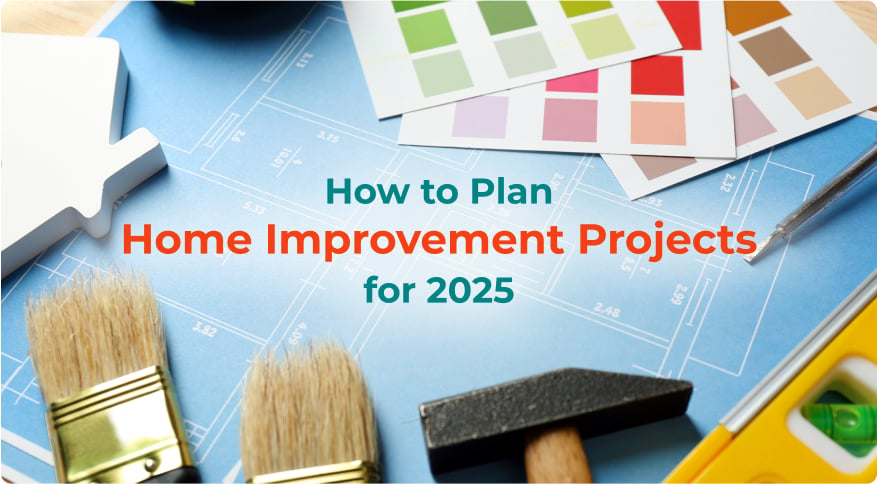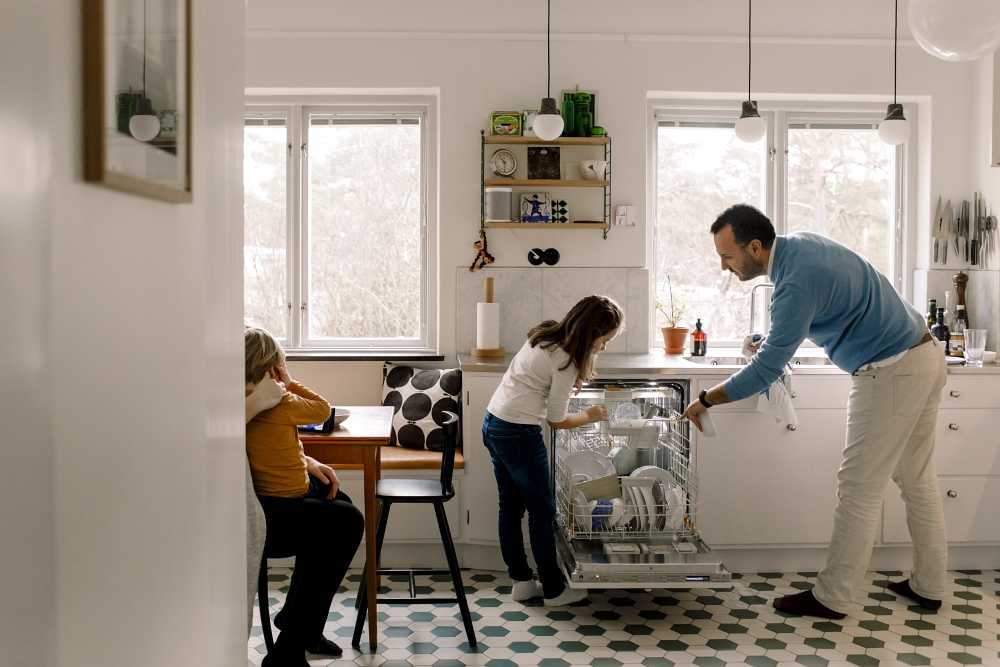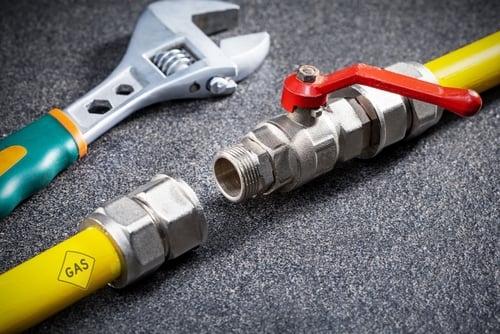Planning a home improvement project for 2025? If you’ve been dreaming of a kitchen makeover or adding an outdoor oasis, you know that getting started can feel a bit overwhelming. But when armed with information about how to plan a home renovation, you can transform your home without stressing about time, cost, or whether you’re in over your head.
1. Define your goals
Before you start ripping out cabinets or sketching plans for a backyard patio, take a step back and ask yourself: What’s the main purpose of this project? Is it purely cosmetic, like fresh paint and new flooring? Or are you tackling something more structural, like fixing foundation issues or expanding your home’s footprint? You’ll also want to think about the long-term benefits. Are you adding value to your home for resale, or is this project more about making your space functional for the next few years?
By defining clear goals, you can avoid jumping into a project that might not align with your overall vision for your home. It’s also a good time to outline both your short-term needs and long-term aspirations. For example, while a sleek, modern kitchen might be top of mind, think about whether you’ll need to consider future needs, like more storage or seating space for a growing family. Keeping both short-term and long-term goals in mind will help you make smarter decisions as the home improvement plan progresses.
2. Create a budget
Once you’ve set your goals, it’s time to talk money. A solid budget is crucial to keeping your home improvement plan on track and avoiding financial surprises. Start by estimating the costs of materials, labor, and any necessary permits. It’s also wise to build in a cushion for unexpected expenses — because, let’s be real, they happen! You can use online resources to get rough estimates on costs or consult with local contractors for a more accurate breakdown.
When creating your budget, it helps to prioritize must-haves over nice-to-haves. Maybe you need new flooring, but the heated towel rack is more of a luxury item. By separating essentials from extras, you can stay flexible if costs start creeping up. Setting a realistic budget up front keeps you on track, and makes sure you don’t run out of steam— or funds— midway through the project.
3. Set a realistic timeline
Home improvement plans take time — usually more than we’d like! The trick is to break your project into manageable phases. Think about the order in which things need to be done: maybe it’s demolition first, then painting, then installing new fixtures. Phasing things out keeps you from feeling overwhelmed and makes it easier to track progress.
Next, factor in lead times. Some materials, like custom cabinets or specialty tiles, can take weeks (or even months) to arrive. Don’t forget about Frontdoor® Pros! Contractors, electricians, and plumbers might not be available right when you need them, so book them in advance. Be sure to build in a little cushion for delays. (We’ve all seen those renovation shows where something unexpected happens, right?) With a solid timeline in place, you’ll feel more in control — and less like you’re living in a construction zone forever.
4. Research and gather inspiration

Whether you’re dreaming of a cozy reading nook or an Instagram-worthy backyard, there’s endless inspiration out there. Pinterest, Instagram, home improvement blogs, and even home tours can be great places to start collecting ideas for your home improvement plans.
Keep in mind, though, that it’s easy to get carried away by picture-perfect spaces. The goal is to balance inspiration with practicality. What works in a giant house on the beach might not translate to your space or budget.
5. Get permits and approvals
Depending on the type of project you’re doing, you might need to get official permission from your local government. Things like electrical upgrades, structural changes, or adding new plumbing usually require permits to ensure everything’s up to code.
The process of getting permits can take time, so you’ll want to factor that into your home improvement plan. You can often apply online or call your city’s permit office for details. If you live in a neighborhood with an HOA (Homeowner’s Association) or a historic district, you might need additional approvals before starting your project.
6. Gather materials and tools
Once you’ve got your permits squared away, it’s time to gather all the materials and tools you’ll need. Make a checklist of everything you need before you start. For big projects, you might want to order materials in bulk to save money or look for seasonal sales to cut costs. Renting larger tools, like tile cutters or power washers, can also help you stay within budget without sacrificing quality.
7. Decide: DIY or call it in?
Okay, now for the big questions: how much of this project can you handle yourself, and when is it time to call in the Pros? DIY can be super rewarding (not to mention cost-effective) for tasks like painting, assembling furniture, or basic landscaping. Plus, the Frontdoor app lets you video chat with home renovation Experts, so if you need advice on how to plan your home improvement projects, or if you’re halfway through a project and hit a snag, you can get professional advice right from your phone.
That said, some jobs are best left to the Pros. Anything involving electrical work, major plumbing, or structural changes should be handled by licensed professionals. With a Frontdoor membership, it’s easy to call in trusted Pros from the local Frontdoor network, straight from the app. That way, if you want to give DIY a try, there’s always a backup when you get out of your depth.
Seasonal timeline: The best time for each project
Here’s a handy breakdown of when to tackle different types of home improvement plans throughout the year. Weather, contractor availability, and the type of project all play a role in deciding the best time to dive in!
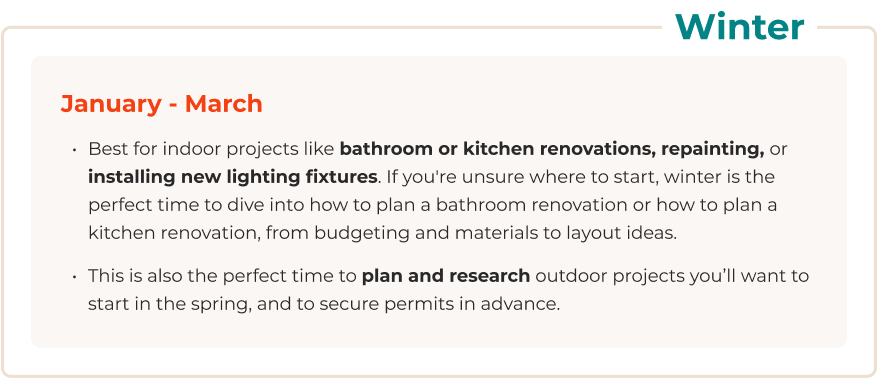

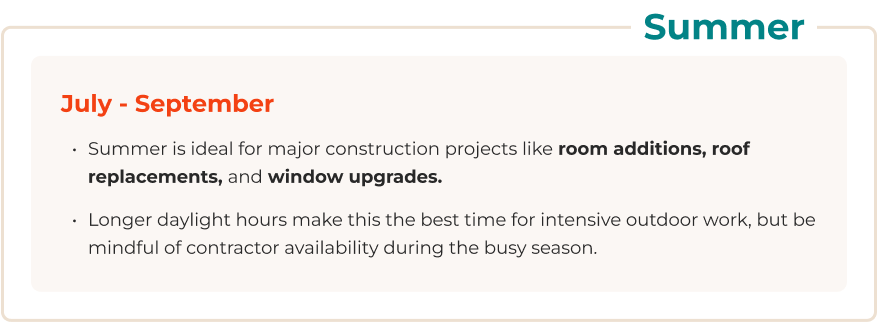

Was this article helpful?

